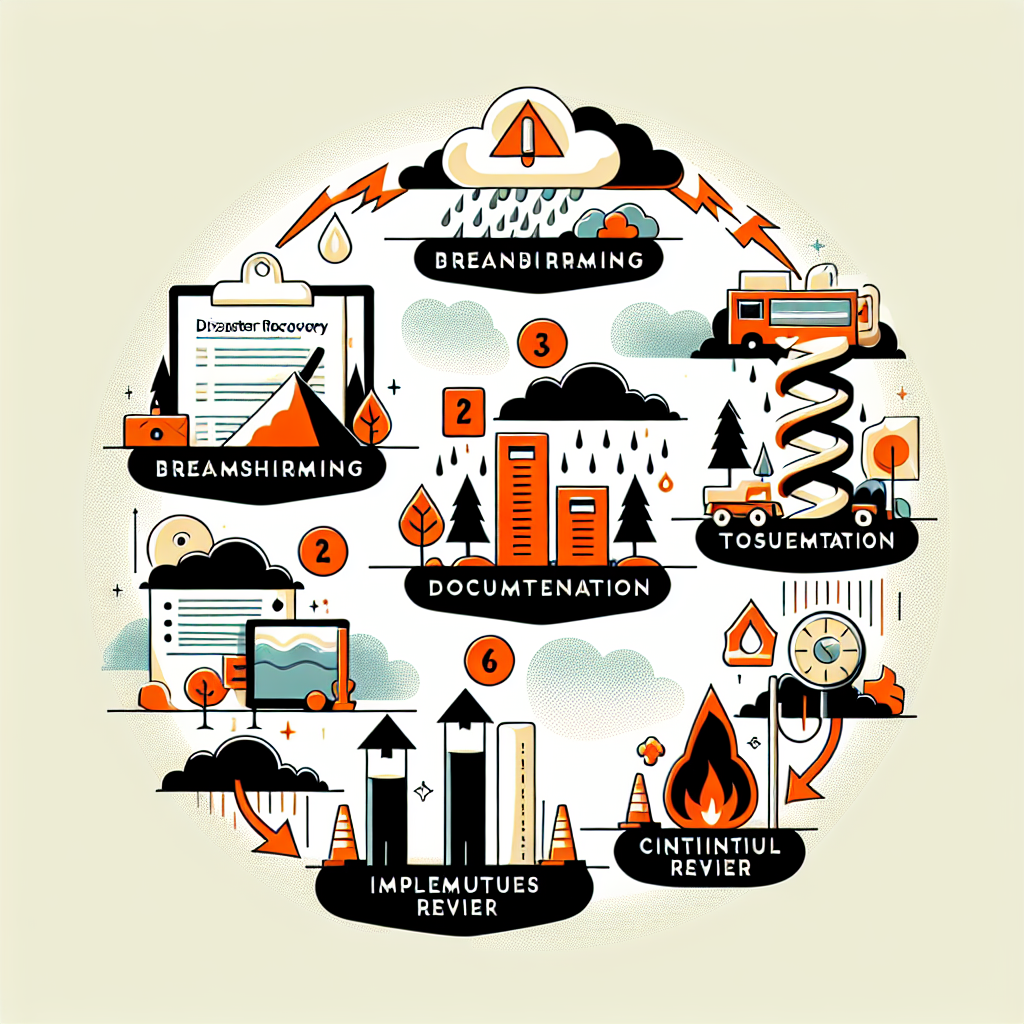Your cart is currently empty!
Tag: Plan

Effective Strategies for Implementing a Disaster Recovery Plan
Disasters can strike at any time, and without warning. Whether it’s a natural disaster like a hurricane or a man-made one like a cyber-attack, businesses need to be prepared for the worst. One way to ensure business continuity in the face of a disaster is to have a solid disaster recovery plan in place. However, simply having a plan is not enough. It is crucial to implement the plan effectively to ensure that it will actually work when needed. Here are some effective strategies for implementing a disaster recovery plan:1. Assign clear roles and responsibilities: One of the most important aspects of implementing a disaster recovery plan is assigning clear roles and responsibilities to team members. Make sure that everyone knows what their role is in the event of a disaster and what is expected of them. This will help to ensure that the plan can be executed smoothly and efficiently.
2. Test the plan regularly: It is not enough to create a disaster recovery plan and then forget about it. Regular testing is essential to ensure that the plan will work when needed. Conducting drills and simulations can help to identify any weaknesses in the plan and make necessary adjustments.
3. Keep the plan up-to-date: Businesses are constantly evolving, and so too should their disaster recovery plans. Make sure to review and update the plan regularly to account for any changes in technology, processes, or personnel. This will help to ensure that the plan remains relevant and effective.
4. Communicate effectively: Communication is key during a disaster. Make sure that everyone involved in the disaster recovery plan is aware of the plan and knows what to do in the event of a disaster. Establish clear lines of communication and ensure that everyone knows how to reach key personnel during a crisis.
5. Consider outsourcing: Implementing a disaster recovery plan can be a complex and time-consuming process. Consider outsourcing the implementation to a third-party provider who specializes in disaster recovery planning. This can help to ensure that the plan is implemented effectively and efficiently.
In conclusion, implementing a disaster recovery plan is essential for business continuity in the face of a disaster. By following these effective strategies, businesses can ensure that their disaster recovery plan is not just a document sitting on a shelf, but a practical and reliable tool to help them weather any storm.

Data Backup and Recovery: Why Your Business Needs a Plan
In today’s digital age, data is the lifeblood of any business. From customer information to financial records, companies rely on data to make informed decisions and drive growth. However, data is also vulnerable to loss or corruption due to various factors such as hardware failure, cyberattacks, human error, or natural disasters. This is why having a solid data backup and recovery plan is essential for every business.Data backup involves making copies of your important files and storing them in a secure location. This ensures that if your original data is lost or corrupted, you can easily restore it from the backup copies. A data recovery plan, on the other hand, outlines the steps to take in case of a data loss incident, including how to retrieve and restore the backed-up data.
There are several reasons why your business needs a data backup and recovery plan. Firstly, data loss can have a significant impact on your business operations. Without access to critical information, you may not be able to serve your customers, make informed decisions, or even continue operating. This can lead to loss of revenue, damage to your reputation, and even legal consequences if sensitive data is compromised.
Secondly, data loss can also result in a financial burden for your business. Data recovery services can be expensive, especially if you need to engage a professional to retrieve your lost data. Additionally, downtime caused by data loss can lead to lost productivity and revenue, further adding to the financial impact.
Moreover, in today’s increasingly digitized world, data security is a top concern for businesses. Cyberattacks such as ransomware and malware can easily compromise your data and hold it hostage for a ransom. Having a data backup and recovery plan in place can help mitigate the risk of data loss from such attacks and ensure that you can quickly recover your data without having to pay a ransom.
In conclusion, data backup and recovery is not just a best practice for businesses—it is a necessity. By implementing a robust plan, you can safeguard your valuable data, minimize the impact of data loss incidents, and ensure the continuity of your business operations. Don’t wait until it’s too late—start developing a data backup and recovery plan for your business today.

5 Key Steps to Developing a Proactive Maintenance Plan
Maintenance is a critical aspect of any business operation, as it ensures that equipment and facilities are running smoothly and efficiently. While reactive maintenance can address immediate issues, proactive maintenance is key to preventing breakdowns and maximizing the lifespan of assets. Developing a proactive maintenance plan involves a strategic approach to identifying and addressing potential issues before they lead to costly repairs or downtime. Here are five key steps to developing a proactive maintenance plan:1. Conduct a thorough assessment: The first step in developing a proactive maintenance plan is to conduct a thorough assessment of all equipment and facilities. This includes identifying all assets that require maintenance, their current condition, and any potential issues that may arise in the future. This assessment should also take into account the frequency of maintenance tasks and the resources needed to perform them.
2. Set maintenance goals and priorities: Once the assessment is complete, it is important to set maintenance goals and priorities based on the criticality of assets and the impact of potential failures on business operations. These goals should be aligned with the overall business objectives and should focus on improving equipment reliability, reducing downtime, and increasing productivity.
3. Develop a maintenance schedule: With maintenance goals and priorities in place, the next step is to develop a maintenance schedule that outlines the frequency and scope of maintenance tasks for each asset. This schedule should be based on best practices for asset maintenance and should take into account factors such as equipment usage, environmental conditions, and manufacturer recommendations.
4. Implement preventive maintenance strategies: Preventive maintenance is a key component of a proactive maintenance plan, as it involves performing regular inspections, cleaning, and servicing of equipment to prevent potential failures. Implementing preventive maintenance strategies can help identify and address issues before they escalate, reducing the risk of unplanned downtime and costly repairs.
5. Monitor and analyze maintenance data: To continuously improve the effectiveness of a proactive maintenance plan, it is important to monitor and analyze maintenance data to identify trends, patterns, and areas for improvement. This data can help identify asset performance issues, optimize maintenance schedules, and make informed decisions about resource allocation.
In conclusion, developing a proactive maintenance plan is essential for ensuring the reliability and efficiency of equipment and facilities. By following these five key steps, businesses can proactively identify and address maintenance issues, reduce downtime, and extend the lifespan of assets. Ultimately, a proactive maintenance plan can help businesses save time and money, improve operational efficiency, and enhance overall business performance.

How to Develop a Strategic IT Infrastructure Management Plan
In today’s fast-paced and technology-driven world, having a strategic IT infrastructure management plan is crucial for the success of any business. An effective plan can help optimize resources, improve efficiency, and ensure the security and stability of your organization’s IT systems.Here are some steps to help you develop a strategic IT infrastructure management plan:
1. Assess Your Current IT Infrastructure:
The first step in developing a strategic IT infrastructure management plan is to assess your current IT infrastructure. This includes identifying all the hardware, software, networks, and systems that make up your IT environment. Evaluate the performance, security, and scalability of your current infrastructure to identify any areas that need improvement.
2. Define Your IT Goals and Objectives:
Once you have a clear understanding of your current IT infrastructure, it’s important to define your goals and objectives for the future. Consider what you want to achieve with your IT systems, whether it’s improving efficiency, reducing costs, enhancing security, or increasing scalability. Your goals and objectives will help guide the development of your IT infrastructure management plan.
3. Identify Key Stakeholders:
It’s important to involve key stakeholders in the development of your IT infrastructure management plan. This includes IT staff, business leaders, and other relevant departments within your organization. By involving stakeholders from the beginning, you can ensure that the plan aligns with the overall business strategy and meets the needs of all stakeholders.
4. Develop a Roadmap:
Once you have assessed your current IT infrastructure, defined your goals and objectives, and involved key stakeholders, it’s time to develop a roadmap for implementing your IT infrastructure management plan. This roadmap should outline specific tasks, timelines, and responsibilities for each phase of the plan.
5. Implement and Monitor:
After developing a roadmap, it’s time to implement your IT infrastructure management plan. This may involve upgrading hardware and software, implementing new security measures, or restructuring your network architecture. Throughout the implementation process, it’s important to monitor progress and make adjustments as needed to ensure that the plan is being executed effectively.
6. Continuously Improve:
Developing a strategic IT infrastructure management plan is not a one-time task. It’s important to continuously monitor and evaluate your IT systems to identify areas for improvement. Regularly review your plan, gather feedback from stakeholders, and make adjustments as needed to ensure that your IT infrastructure is aligned with your business goals and objectives.
In conclusion, developing a strategic IT infrastructure management plan is essential for the success of any organization. By assessing your current IT infrastructure, defining your goals and objectives, involving key stakeholders, developing a roadmap, implementing and monitoring the plan, and continuously improving, you can ensure that your IT systems are optimized for performance, security, and scalability.

6 Key Steps to Developing an Effective Disaster Recovery Plan
In today’s digital age, businesses rely heavily on technology to operate efficiently and effectively. However, with this reliance comes the risk of data loss and system downtime in the event of a disaster. That’s why it’s crucial for businesses to have a comprehensive disaster recovery plan in place to ensure that they can quickly recover and resume operations in the face of any unforeseen events.Developing an effective disaster recovery plan can be a complex and time-consuming process, but it is essential for the long-term success and survival of any business. To help you get started, here are six key steps to developing an effective disaster recovery plan:
1. Identify potential risks: The first step in developing a disaster recovery plan is to identify the potential risks that could impact your business. This could include natural disasters such as floods, hurricanes, or earthquakes, as well as man-made disasters such as cyber-attacks, power outages, or equipment failures. By understanding the potential risks, you can better prepare for them and mitigate their impact on your business.
2. Assess the impact: Once you have identified the potential risks, you need to assess the impact that each one could have on your business. This includes determining the potential financial losses, operational disruptions, and reputational damage that could occur as a result of a disaster. By understanding the potential impact, you can prioritize your recovery efforts and allocate resources accordingly.
3. Define recovery objectives: Next, you need to define the recovery objectives for your business. This includes establishing the recovery time objectives (RTOs) and recovery point objectives (RPOs) for each critical business process and system. RTOs and RPOs help determine how quickly you need to recover and how much data loss is acceptable in the event of a disaster.
4. Develop a recovery strategy: Based on your identified risks, impact assessment, and recovery objectives, you can now develop a recovery strategy. This includes outlining the steps that need to be taken to recover critical systems and data, as well as the resources and tools that will be needed to execute the plan. It’s important to involve key stakeholders from across the organization in developing the recovery strategy to ensure buy-in and support.
5. Test and update the plan: Once you have developed a disaster recovery plan, it’s essential to test it regularly to ensure that it will be effective in a real-life scenario. This includes conducting tabletop exercises, simulations, and full-scale drills to identify any weaknesses or gaps in the plan. Additionally, it’s important to update the plan regularly to reflect changes in technology, infrastructure, and business processes.
6. Document and communicate the plan: Finally, it’s crucial to document the disaster recovery plan and communicate it to all relevant stakeholders within your organization. This includes providing training and guidance on their roles and responsibilities in the event of a disaster, as well as ensuring that everyone understands the importance of the plan and their role in executing it.
In conclusion, developing an effective disaster recovery plan is a critical aspect of business continuity and resilience. By following these six key steps, businesses can better prepare for and respond to any disasters that may occur, ensuring that they can quickly recover and resume operations with minimal disruption.

Implementing a Proactive Maintenance Plan: Tips and Best Practices
Implementing a Proactive Maintenance Plan: Tips and Best PracticesMaintenance is a crucial aspect of keeping any facility or equipment running smoothly and efficiently. While reactive maintenance may be necessary at times, implementing a proactive maintenance plan can help prevent costly breakdowns and downtime. By taking a proactive approach, businesses can save time, money, and resources in the long run.
Here are some tips and best practices for implementing a proactive maintenance plan:
1. Conduct regular inspections: Regular inspections of equipment and facilities are essential for identifying potential issues before they become major problems. By identifying and addressing issues early on, businesses can prevent costly repairs and downtime.
2. Create a maintenance schedule: Establishing a regular maintenance schedule can help ensure that all equipment and facilities are properly maintained. This schedule should include routine tasks such as lubricating moving parts, cleaning filters, and checking for wear and tear.
3. Utilize technology: There are many software programs and tools available that can help businesses track and manage their maintenance activities. These tools can help businesses schedule maintenance tasks, track equipment history, and generate maintenance reports.
4. Train staff: Properly trained staff are essential for implementing a proactive maintenance plan. Make sure that all employees are trained on how to properly maintain equipment and facilities. Regular training sessions can help ensure that staff are up to date on the latest maintenance practices.
5. Prioritize maintenance tasks: Not all maintenance tasks are created equal. It’s important to prioritize tasks based on their importance and impact on operations. Focus on tasks that are critical to the operation of the business and address them first.
6. Monitor performance: Regularly monitoring equipment performance can help businesses identify potential issues before they become major problems. Keep track of key performance indicators and use this data to make informed decisions about maintenance activities.
7. Establish a feedback loop: Encourage employees to report any maintenance issues they encounter. By creating a feedback loop, businesses can quickly address problems and prevent them from escalating.
By implementing a proactive maintenance plan, businesses can improve efficiency, reduce downtime, and save money in the long run. By conducting regular inspections, creating a maintenance schedule, utilizing technology, training staff, prioritizing tasks, monitoring performance, and establishing a feedback loop, businesses can ensure that their equipment and facilities are properly maintained and running smoothly.

Strategies for Implementing a Successful IT Infrastructure Management Plan
In today’s technology-driven world, having a successful IT infrastructure management plan is essential for businesses to stay competitive and efficient. A well-thought-out IT infrastructure management plan can help organizations optimize their resources, streamline operations, and improve overall productivity. However, implementing such a plan can be daunting, especially for those who are not well-versed in IT infrastructure management. To help businesses navigate this process, here are some strategies for implementing a successful IT infrastructure management plan.1. Assess current infrastructure: Before implementing any changes, it is crucial to assess the current state of your IT infrastructure. This includes evaluating the hardware, software, network, security protocols, and overall IT environment. Understanding the strengths and weaknesses of your current infrastructure will help you identify areas that need improvement and prioritize where to focus your efforts.
2. Define goals and objectives: Clearly define your goals and objectives for your IT infrastructure management plan. Whether it is to improve network performance, enhance data security, or optimize resource utilization, having well-defined goals will help guide your decision-making process and measure the success of your plan.
3. Involve key stakeholders: It is important to involve key stakeholders in the planning and implementation of your IT infrastructure management plan. This includes IT staff, department heads, and senior management. By involving stakeholders from various departments, you can ensure that the plan aligns with the overall business objectives and meets the needs of all stakeholders.
4. Develop a roadmap: Create a detailed roadmap outlining the steps and timeline for implementing your IT infrastructure management plan. This roadmap should include specific tasks, responsibilities, and deadlines to keep everyone on track and accountable for their roles in the implementation process.
5. Invest in the right technology: To successfully implement your IT infrastructure management plan, you may need to invest in new technology or upgrade existing systems. It is important to carefully evaluate and select technologies that align with your goals and objectives, as well as fit within your budget and IT capabilities.
6. Monitor and evaluate progress: Regularly monitor and evaluate the progress of your IT infrastructure management plan. This includes tracking key performance indicators, analyzing data, and gathering feedback from stakeholders. By monitoring progress, you can identify any issues or bottlenecks early on and make necessary adjustments to ensure the success of your plan.
7. Continuously improve: IT infrastructure management is an ongoing process that requires continuous improvement. As technology evolves and business needs change, it is important to adapt and refine your IT infrastructure management plan accordingly. Regularly review and update your plan to ensure that it remains relevant and effective in meeting the needs of your organization.
In conclusion, implementing a successful IT infrastructure management plan requires careful planning, collaboration, and a commitment to continuous improvement. By following these strategies, businesses can set themselves up for success and ensure that their IT infrastructure is optimized for maximum efficiency and productivity.

How to Create a Disaster Recovery Plan That Works
Disasters can strike at any moment, whether it be a natural disaster like a hurricane or a man-made disaster like a cyber attack. That’s why it’s crucial for businesses to have a disaster recovery plan in place to ensure they can continue operating in the event of a crisis. However, simply having a plan is not enough – it must be effective and actionable in order to truly protect your organization. Here are some key steps to creating a disaster recovery plan that works.1. Identify your critical assets: The first step in creating a disaster recovery plan is to identify your organization’s critical assets. These could include things like data, equipment, facilities, and key personnel. By understanding what is most important to your business, you can prioritize your recovery efforts and ensure that you can quickly get back up and running after a disaster.
2. Conduct a risk assessment: Once you have identified your critical assets, you need to assess the risks that could impact them. This could include natural disasters, cyber attacks, power outages, and more. By understanding the potential threats to your organization, you can better plan for how to mitigate these risks and respond in the event of a disaster.
3. Develop a response plan: With a clear understanding of your critical assets and the risks they face, you can now develop a response plan. This plan should outline the steps that need to be taken in the event of a disaster, including how to protect your assets, how to communicate with employees and stakeholders, and how to continue operations in a disrupted environment. Make sure to test your response plan regularly to ensure it is effective and up to date.
4. Backup your data: One of the most important aspects of a disaster recovery plan is backing up your data. Make sure to regularly back up all of your critical data and store it in a secure location. This will ensure that you can quickly recover your data in the event of a disaster and continue operating without significant disruption.
5. Train your employees: Your employees are a key part of your disaster recovery plan, so make sure to train them on their roles and responsibilities in the event of a disaster. This could include things like how to safely evacuate a building, how to access critical systems remotely, and how to communicate with other team members during a crisis.
6. Review and update your plan regularly: Finally, it’s important to regularly review and update your disaster recovery plan to ensure it remains effective. As your organization grows and changes, so too will the risks it faces. By regularly reviewing and updating your plan, you can ensure that it continues to protect your organization in the event of a disaster.
In conclusion, creating a disaster recovery plan that works requires careful planning, assessment, and testing. By following these key steps, you can ensure that your organization is prepared to respond effectively to any disaster that may come its way. Remember, it’s not a matter of if a disaster will strike, but when – so make sure you have a plan in place to protect your business and keep it running smoothly in the face of adversity.
Tips for Creating an Effective Data Backup and Recovery Plan
Data is essential for any business, and losing it can be catastrophic. That’s why having a solid data backup and recovery plan is crucial. Here are some tips for creating an effective plan to ensure your business can quickly recover from any data loss.1. Identify Critical Data: The first step in creating a data backup and recovery plan is to identify the critical data that needs to be backed up. This includes customer information, financial records, and any other data that is vital to the operation of your business.
2. Choose the Right Backup Solution: There are several backup solutions available, including cloud storage, external hard drives, and tape backups. It’s important to choose a solution that is reliable, secure, and easy to use. Consider using a combination of backup solutions to ensure redundancy in case one fails.
3. Schedule Regular Backups: Set up a regular backup schedule to ensure that your data is always up to date. This could be daily, weekly, or monthly backups, depending on the volume of data your business generates.
4. Test Your Backups: It’s not enough to just set up backups – you also need to regularly test them to ensure they are working correctly. This will help you identify any issues before they become a problem and ensure that your data can be easily recovered in case of a disaster.
5. Implement Security Measures: Data backups should be encrypted to protect sensitive information from unauthorized access. Additionally, limit access to backup files to only authorized personnel to prevent data breaches.
6. Create a Disaster Recovery Plan: In addition to regular data backups, it’s important to have a disaster recovery plan in place. This plan should outline the steps to be taken in case of a data loss, including who is responsible for managing the recovery process and how long it will take to restore data.
7. Train Your Employees: Make sure your employees are trained on how to properly back up data and follow security protocols. This will help prevent accidental data loss and ensure that everyone is on the same page when it comes to data backup and recovery.
In conclusion, creating an effective data backup and recovery plan is essential for any business. By following these tips, you can ensure that your data is safe and secure, and that your business can quickly recover from any data loss. Remember, it’s better to be prepared for a data loss than to face the consequences of not having a plan in place.

